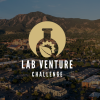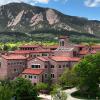Climate, Energy & Sustainability
 CU Boulder Today—A team of University of Colorado Boulder researchers is making reliable, inexpensive and easy-to-deploy sensors that monitor soil in real time and have formed a new startup, Tierra Metrics.
CU Boulder Today—A team of University of Colorado Boulder researchers is making reliable, inexpensive and easy-to-deploy sensors that monitor soil in real time and have formed a new startup, Tierra Metrics. Eleven teams of University of Colorado faculty, researchers and graduate student innovators competed for a combined $755,000 in startup funding grants in this year’s Lab Venture Challenge (LVC). Judges from CU's entrepreneurial network heard Shark-Tank-style pitches across two nights, one for innovations in biosciences and another for physical sciences and engineering.
Eleven teams of University of Colorado faculty, researchers and graduate student innovators competed for a combined $755,000 in startup funding grants in this year’s Lab Venture Challenge (LVC). Judges from CU's entrepreneurial network heard Shark-Tank-style pitches across two nights, one for innovations in biosciences and another for physical sciences and engineering. From agriculture to aerospace, NSF’s I-Corps is a launchpad at the University of Colorado Boulder, helping innovators in and out of the University of Colorado bring research and inventions to the people who need them most. By equipping scientists and inventors with entrepreneurial tools, the program transforms great ideas into startups that tackle real-world problems.
From agriculture to aerospace, NSF’s I-Corps is a launchpad at the University of Colorado Boulder, helping innovators in and out of the University of Colorado bring research and inventions to the people who need them most. By equipping scientists and inventors with entrepreneurial tools, the program transforms great ideas into startups that tackle real-world problems. CU Boulder Environmental Engineering Program—Mark Hernandez is serving as a commissioner of the newly launched Global Commission on Healthy Indoor Air to elevate indoor air as a critical public health priority and drive coordinated global action and solutions.
CU Boulder Environmental Engineering Program—Mark Hernandez is serving as a commissioner of the newly launched Global Commission on Healthy Indoor Air to elevate indoor air as a critical public health priority and drive coordinated global action and solutions. Eleven teams of University of Colorado entrepreneurs, faculty researchers and graduate student innovators will compete for a combined $750,000 in startup funding grants in this year’s Lab Venture Challenge (LVC) Showcases at the Dairy Arts Center. Judges from Venture Partners at CU Boulder’s entrepreneurial network will hear Shark Tank-style pitches across two nights, one for innovations in biosciences and another for physical sciences and engineering.
Eleven teams of University of Colorado entrepreneurs, faculty researchers and graduate student innovators will compete for a combined $750,000 in startup funding grants in this year’s Lab Venture Challenge (LVC) Showcases at the Dairy Arts Center. Judges from Venture Partners at CU Boulder’s entrepreneurial network will hear Shark Tank-style pitches across two nights, one for innovations in biosciences and another for physical sciences and engineering. Cooperative Institute for Research in Environmental Sciences (CIRES)—CIRES and NOAA scientists have developed the Hourly Wildfire Potential Index (HWP)—an hourly updated assessment of wildfire risk across every nine square kilometers of land. The tool enhances existing weather prediction models by providing more accurate, real-time forecasts of wildfire activity and associated smoke emissions.
Cooperative Institute for Research in Environmental Sciences (CIRES)—CIRES and NOAA scientists have developed the Hourly Wildfire Potential Index (HWP)—an hourly updated assessment of wildfire risk across every nine square kilometers of land. The tool enhances existing weather prediction models by providing more accurate, real-time forecasts of wildfire activity and associated smoke emissions. The New York Times—CU Boulder entomologist Sammy Ramsey is leading international efforts to combat the Tropilaelaps mite, a newly identified parasite threatening honeybee populations worldwide. His research highlights the urgent need for global biosecurity measures to protect pollinators essential to food systems and ecosystems alike.
The New York Times—CU Boulder entomologist Sammy Ramsey is leading international efforts to combat the Tropilaelaps mite, a newly identified parasite threatening honeybee populations worldwide. His research highlights the urgent need for global biosecurity measures to protect pollinators essential to food systems and ecosystems alike. The Conversation—Over the past several months, universities have lost more than $11 billion in funding. Research into cancer, farming solutions and climate resiliency are just a few of the many projects nationally that have seen cuts. The Conversation asked Massimo Ruzzene, senior vice chancellor for research and innovation at the University of Colorado Boulder, to explain how these cuts and freezes are impacting the university and Colorado’s local economy.
The Conversation—Over the past several months, universities have lost more than $11 billion in funding. Research into cancer, farming solutions and climate resiliency are just a few of the many projects nationally that have seen cuts. The Conversation asked Massimo Ruzzene, senior vice chancellor for research and innovation at the University of Colorado Boulder, to explain how these cuts and freezes are impacting the university and Colorado’s local economy. CU Boulder College of Engineering and Applied Science—Researchers at the University of Colorado Boulder have created a new way to build and control tiny particles that can move and work like microscopic robots, offering a powerful tool with applications in biomedical and environmental research.
CU Boulder College of Engineering and Applied Science—Researchers at the University of Colorado Boulder have created a new way to build and control tiny particles that can move and work like microscopic robots, offering a powerful tool with applications in biomedical and environmental research. Information Technology & Innovation Foundation (ITIF)—According to a new report, American research universities like the University of Colorado in recent decades have become engines of innovation for state and regional economies, thanks in large part to the federal Bayh-Dole Act, which incentivizes technology commercialization.
Information Technology & Innovation Foundation (ITIF)—According to a new report, American research universities like the University of Colorado in recent decades have become engines of innovation for state and regional economies, thanks in large part to the federal Bayh-Dole Act, which incentivizes technology commercialization.


